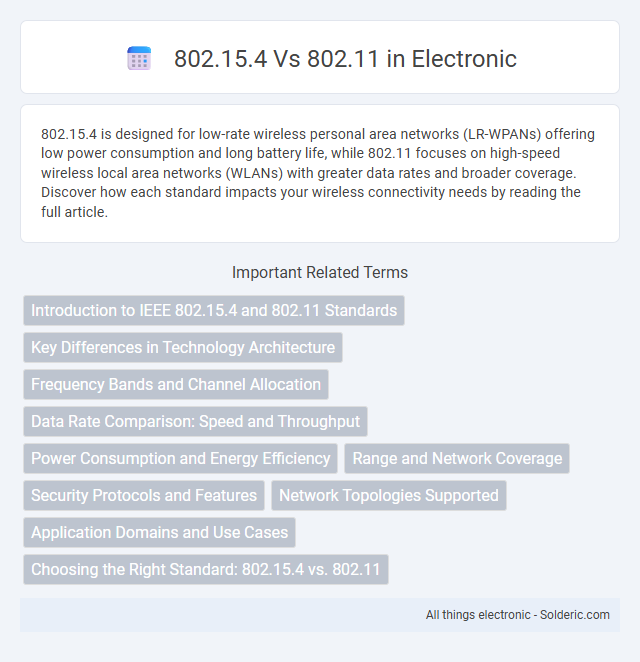802.15.4 is designed for low-rate wireless personal area networks (LR-WPANs) offering low power consumption and long battery life, while 802.11 focuses on high-speed wireless local area networks (WLANs) with greater data rates and broader coverage. Discover how each standard impacts your wireless connectivity needs by reading the full article.
Comparison Table
| Feature | IEEE 802.15.4 | IEEE 802.11 |
|---|---|---|
| Purpose | Low-rate Wireless Personal Area Networks (LR-WPANs) | Wireless Local Area Networks (WLANs) |
| Frequency Bands | 2.4 GHz, 868 MHz, 915 MHz | 2.4 GHz, 5 GHz, 6 GHz |
| Data Rate | 20 kbps to 250 kbps | Up to 9.6 Gbps (802.11ax) |
| Range | 10-100 meters | 50-100 meters indoors, up to 300 meters outdoors |
| Power Consumption | Very low (suitable for battery-powered devices) | Moderate to high |
| Application | IoT devices, sensor networks, home automation | Internet access, multimedia streaming, enterprise networks |
| Topology | Star, peer-to-peer, mesh | Infrastructure and ad hoc |
| Security | 128-bit AES encryption | WPA3, WPA2 with AES encryption |
Introduction to IEEE 802.15.4 and 802.11 Standards
IEEE 802.15.4 is a standard designed for low-rate wireless personal area networks (LR-WPANs), emphasizing low power consumption and short-range communication, commonly used in IoT and sensor networks. In contrast, IEEE 802.11 defines wireless local area networks (WLANs) with higher data rates and longer ranges, supporting applications such as Wi-Fi internet access. Both standards serve distinct networking purposes, with 802.15.4 optimized for energy efficiency and simplicity, while 802.11 prioritizes throughput and broader coverage.
Key Differences in Technology Architecture
IEEE 802.15.4 is designed for low-rate wireless personal area networks (LR-WPANs), emphasizing low power consumption, low data rates (up to 250 kbps), and simple network topologies suitable for IoT and sensor networks. In contrast, IEEE 802.11, commonly known as Wi-Fi, supports higher data rates ranging from 11 Mbps to several Gbps with more complex architectures, including multiple-input multiple-output (MIMO) technology and wide spectrum bands to facilitate robust, high-throughput local area networking. The protocol stack of 802.15.4 is minimalistic, focusing on efficient, low-latency MAC operations with features like beacon-enabled modes, while 802.11 incorporates extensive security, QoS, and adaptive modulation schemes to maintain performance across diverse and dense network environments.
Frequency Bands and Channel Allocation
IEEE 802.15.4 operates primarily in the 2.4 GHz, 915 MHz, and 868 MHz frequency bands, optimized for low-rate wireless personal area networks (LR-WPANs) with 16 channels at 2.4 GHz, offering minimal interference and low power consumption. In contrast, IEEE 802.11, commonly known as Wi-Fi, utilizes the 2.4 GHz and 5 GHz bands with a broader channel allocation, supporting higher data rates but typically consuming more power. Understanding these differences helps you choose the appropriate standard based on your application's range, interference environment, and power requirements.
Data Rate Comparison: Speed and Throughput
IEEE 802.15.4 supports data rates up to 250 kbps, optimized for low-power and low-data-rate applications such as sensor networks. In contrast, IEEE 802.11 standards, including Wi-Fi variants, offer significantly higher speeds, ranging from 11 Mbps in 802.11b to multi-gigabit rates in newer versions like 802.11ax. The throughput difference reflects 802.11's suitability for high-bandwidth tasks, while 802.15.4 prioritizes energy efficiency and reliability over speed.
Power Consumption and Energy Efficiency
IEEE 802.15.4 offers significantly lower power consumption and higher energy efficiency compared to IEEE 802.11, making it ideal for low-data-rate applications such as wireless sensor networks and IoT devices. The 802.15.4 standard supports low-duty-cycle operation and sleep modes that drastically reduce energy usage, enabling devices to run for years on small batteries. In contrast, IEEE 802.11 prioritizes high throughput and faster data rates, which results in higher power demands unsuitable for energy-constrained environments.
Range and Network Coverage
802.15.4 offers low-power, short-range wireless communication ideal for personal area networks, typically covering distances up to 10-100 meters, making it suitable for sensor and IoT devices. In contrast, 802.11 (Wi-Fi) provides higher data rates and extended range, supporting network coverage up to 100-300 meters indoors and even more in open spaces, ideal for larger-scale wireless local area networks. Your choice depends on whether you prioritize energy-efficient, close-range connectivity or broader network coverage with higher throughput.
Security Protocols and Features
802.15.4 employs AES-128 encryption with link-layer security, providing confidentiality, data integrity, and message freshness, essential for low-power IoT devices. In contrast, 802.11 (Wi-Fi) incorporates more robust security protocols like WPA3, offering advanced authentication methods and enhanced protection against modern cyber threats. Understanding these differences helps you choose the appropriate standard based on your network's security requirements and device capabilities.
Network Topologies Supported
802.15.4 supports star, peer-to-peer, and mesh topologies, making it ideal for low-power, low-data-rate applications like IoT and sensor networks. In contrast, 802.11 primarily uses infrastructure and ad-hoc topologies, optimized for high data rates in WLAN scenarios. Your choice depends on the network scale and device connectivity requirements, with 802.15.4 excelling in flexible, energy-efficient layouts.
Application Domains and Use Cases
IEEE 802.15.4 is primarily used in low-power, low-data-rate wireless communication applications such as Internet of Things (IoT), home automation, industrial sensor networks, and smart metering, where energy efficiency and long battery life are critical. IEEE 802.11, commonly known as Wi-Fi, supports high-throughput wireless local area networking (WLAN) for applications including internet access, video streaming, and enterprise connectivity, prioritizing data speed and coverage. The distinct use cases reflect 802.15.4's optimization for mesh networking and scalability in sensor networks versus 802.11's focus on broadband connectivity and multimedia data transmission.
Choosing the Right Standard: 802.15.4 vs. 802.11
Choosing between IEEE 802.15.4 and 802.11 hinges on your application's requirements for power consumption, data rate, and range. 802.15.4 supports low-power, low-data-rate wireless personal area networks (WPANs) ideal for sensor networks, home automation, and IoT devices, while 802.11 accommodates high-throughput wireless local area networks (WLANs) suited for video streaming and internet browsing. For your project, prioritize 802.15.4 if energy efficiency and extended battery life are critical, whereas 802.11 is best for bandwidth-intensive tasks with higher power availability.
802.15.4 vs 802.11 Infographic

 solderic.com
solderic.com